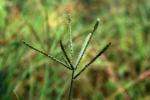Latin name
Eleusine indica (L.) Gaertner
Family
Poaceae
Common name(s)
Goosegrass, wire grass, crowfoot grass, bullgrass
Synonym(s)
Eleusine polydactyla Steudel, E. gracilis Salisb., E. scabra E. Fourn. ex Hemsl., E. domingensis Sieber ex Schult., E. indica var. major E. Fourn., Cynodon indicus Raspail, Cynosurus indicus L. (basionym)
Geographical distribution
Asia: Japan.
South and Southeast Asia: Bangladesh, India, Indonesia, Lao PDR, Malaysia, Nepal, Pakistan, Philippines, Sri Lanka, Thailand, and Vietnam.
Rest of the world: Argentina, Australia, Brazil, Bulgaria, Cuba, Dominican Republic, Egypt, Fiji, France, Germany, Ghana, Guatemala, Hungary, Jamaica, Kenya, Mexico, Netherlands, New Zealand, Nicaragua, Nigeria, Pacific Islands, Peru, Portugal, Puerto Rico, Surinam, Uganda, United States, Venezuela, Zambia, and Zimbabwe.
Morphology
Erect or ascending annual, stout and strongly fibrous, up to 60—cm—tall.
Stem: tufted, smooth, laterally flattened and whitish or pale green.
Leaf: linear, smooth, 10—30—cm—long; blades flattened laterally with a few long hairs at the base; ligule short and membranous.
Inflorescence: digitately arranged spikes; terminal whorl of 2—6 spikes is 6—12—cm—long; 1 or 2 additional spikes are often present slightly below the others; spikelets numerous, sessile, awnless, and closely crowded into two rows along the underside of the flattened rachis; spikelets 4—5.5—mm—long.
Biology and ecology
Propagates by seeds and seeds remain viable for 2—5 years. Germination occurs mainly in the top 5—cm of soil. Livestock disperse seed in their droppings.
Eleusine indica is a C4 species; it grows in full sunlight and flowers throughout the year. It is found in upland areas in wastelands, roadsides, maize, cotton, sugarcane, sweet potatoes, and upland and rainfed lowland rice.
Agricultural importance
Eleusine indica can be a serious weed and is widespread and common.
In rice fields, the weed serves as an alternate host of insect pests such as Cicadulina bipunctata (Melichar), Cnaphalocrocis medinalis (Guenee), Creatonotus gangis L., Euscyrtus concinnus (de Haan), Haplothrips ganglbaueri Schmutz, Hysteroneura setariae (Thomas), Leptocorisa spp., Marasmia spp., Nephotettix spp., Pseudococcus saccharicola Takahashi, Sesamia inferens (Walker), Spodoptera mauritia acronyctoides (Guenee), and Tetraneura nigriabdominalis (Sasaki), and diseases such as ragged stunt and rice yellow mottle virus.
Management
Cultural control: good land preparation and hand weeding can be effective.
Biological control: in field tests in South Carolina (USA), two leaf-spotting pathogens, Bipolaris setariae and Pyricularia grisea, were effective pathogens.
Chemical control: Glufosinate ammonium or glyphosate.
Selected references
Barrion AT, Litsinger JA, Medina EB, Aguda RM, Bandong JP, Pantua Jr. PC, Viajante VD, dela Cruz CE, Vega CR, Soriano JS, Camañag, EE, Saxena RC, Tryon EH, Shepard BM. 1991. The rice Cnaphalocrocis and Marasmia (Lepidoptera: Pyralidae) leaffolder complex in the Philippines: taxonomy, bionomics, and control. Philipp. Entomol. 8:987-1074.
Catindig JLA, Barrion AT, Litsinger JA. 1994. Host plant range of leafhopper Cicadulina bipunctata (Melichar). Int. Rice Res. Notes 19:22.
Figliola SS, Camper ND, Ridings WH. 1988. Potential biological control agents for goosegrass (Eleusine indica). Weed Sci. 36:830-835.
Fulwider JR, Engel RE. 1959. The effect of temperature and light on germination of seed goosegrass, Eleusine indica. Weeds 7:359-361.
Galinato I, Moody K, Piggin. CM. 1999. Upland rice weeds of South and Southeast Asia. Manila (Philippines): International Rice Research Institute. 156 p.
Holm LG, Plucknett DL, Pancho JV, Herberger JP. 1977. The world's worst weeds: distribution and biology. Honolulu, Hawaii (USA): University of Hawaii Press. 609 p.
Kenji N, Teerawatsakul M, Prakongvongs C, Chaiwiratnukul L. 1986. Major weeds in Thailand. National Weed Science Research Institute Project. Bangkok (Thailand): Department of Agriculture. 142 p.
Moody K. 1989. Weeds reported in rice in South and Southeast Asia. Manila (Philippines): International Rice Reseach Institute. 442 p.
Pancho JV, Obien SR. 1995. Manual of ricefield weeds in the Philippines. Muñoz, Nueva Ecija (Philippines): Philippine Rice Research Institute. 543 p.
Soerjani M, Kostermans AJGH, Tjitrosoepomo G. 1987. Weeds of rice in Indonesia. Jakarta (Indonesia): Balai Pustaka. 716 p.
Contributors
JLA Catindig, RT Lubigan, and DE Johnson
